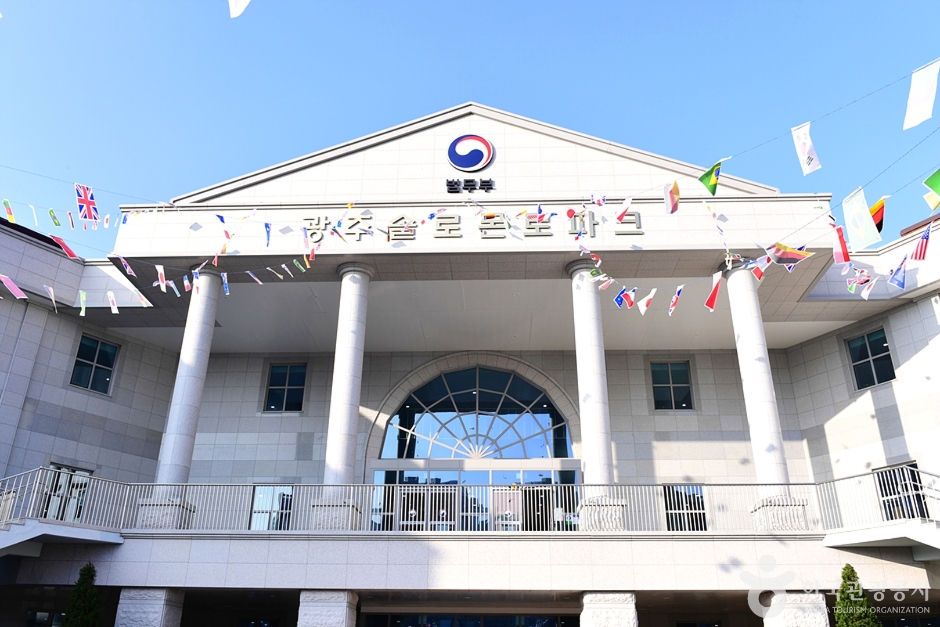Lotte Himart - Gwangju World Cup Branch [Tax Refund Shop] (롯데하이마트 광주월드컵점)
6.6Km 2024-04-16
240, Geumhwa-ro, Seo-gu, Gwangju
-
Lotte Mart - World Cup Branch [Tax Refund Shop] (롯데마트 월드컵점)
6.6Km 2024-04-22
240, Geumhwa-ro, Seo-gu, Gwangju
-
Gwangju KIA Champions Field (광주-기아 챔피언스 필드)
6.6Km 2025-08-06
10 Seorim-ro, Buk-gu, Gwangju
070-7686-8000
Gwangju KIA Champions Field is the first open-air stadium in the country and houses INC COFFEE, making it a must-visit attraction for baseball fans. The café offers spacious seating and various bakery items– with the baseball-shaped bread being the most popular. There is also a photo zone, allowing visitors to capture the memories of their trip. With a seating capacity of 20,500, tickets for the seats can be purchased online or on-site.
Solomon Law Park (솔로몬로파크)
6.7Km 2024-04-23
219-39 Expo-ro, Yuseong-gu, Daejeon
Solomon Law Park is a theme park operated by the Ministry of Justice, offering an experiential legal education. Visitors can learn about and experience the law in an easy and entertaining way. The Law Experience Center provides opportunities to experience legislation, investigation, courtrooms, and prisons. The park includes a Law Playground, as well as amenities like a leisure area and a convenience store.
Gucci - Shinsegae Gwangju Branch [Tax Refund Shop] (구찌 신세계 광주점)
6.7Km 2024-04-23
1F, 932, Mujin-daero, Seo-gu, Gwangju
-
Balenciaga - Shinsegae Gwangju Branch [Tax Refund Shop] (발렌시아가 신세계 광주점)
6.7Km 2024-04-18
932, Mujin-daero, Seo-gu, Gwangju
-
YSL - Shinsegae Gwangju Branch [Tax Refund Shop] (입생로랑 신세계 광주점)
6.7Km 2024-04-18
2F, 932, Mujin-daero, Seo-gu, Gwangju
-
Beanpole - Shinsegae Gwangju Branch [Tax Refund Shop] (빈폴 신세계 광주점)
6.7Km 2024-06-27
932, Mujin-daero, Seo-gu, Gwangju
-
Burberry Kids - Shinsegae Gwangju Branch [Tax Refund Shop] (버버리 아동 신세계 광주점)
7.0Km 2024-04-23
8F, 904, Mujin-daero, Seo-gu, Gwangju
-
Burberry - Shinsegae Gwangju Branch [Tax Refund Shop] (버버리 신세계 광주점)
7.0Km 2024-04-23
1F, 904, Mujin-daero, Seo-gu, Gwangju
-
![Lotte Himart - Gwangju World Cup Branch [Tax Refund Shop] (롯데하이마트 광주월드컵점)](http://tong.visitkorea.or.kr/cms/resource/31/2886931_image2_1.jpg)
![Lotte Mart - World Cup Branch [Tax Refund Shop] (롯데마트 월드컵점)](http://tong.visitkorea.or.kr/cms/resource/30/2886930_image2_1.jpg)


![Beanpole - Shinsegae Gwangju Branch [Tax Refund Shop] (빈폴 신세계 광주점)](http://tong.visitkorea.or.kr/cms/resource/38/3313838_image2_1.jpg)
 English
English
 한국어
한국어 日本語
日本語 中文(简体)
中文(简体) Deutsch
Deutsch Français
Français Español
Español Русский
Русский